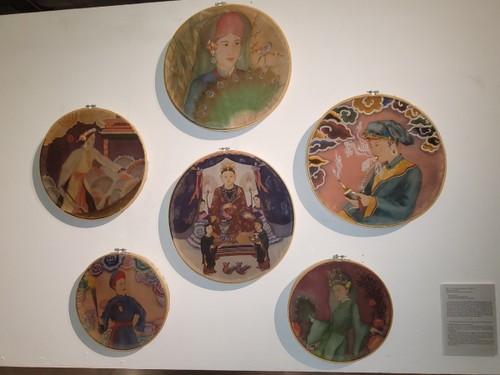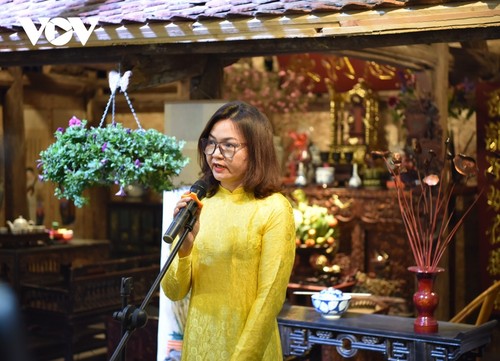 Hang Trong folk paintings are made by young artists using lacquer and silk. (Photo: VOV) Hang Trong folk paintings are made by young artists using lacquer and silk. (Photo: VOV) |
Hanoi is considered the "capital" of handicrafts. Mentioning Hanoi is to refer to guild streets such as Hang Thiec (tinsmith), Hang Bac (silversmith), or Lo Ren (blacksmith), each street name bearing the imprint of a traditional craft. Following the ups and downs of history, most of the streets have kept their name, but the craft associated with the street name has gradually faded. Many have become commercial streets.
Trann Thi Thuy Lan, Deputy Head of the Management Board of Hoan Kiem Lake and the Hanoi Old Quarter, said, “There aren’t many craft villages in downtown Hanoi, which is now mainly for selling products. We’re trying to connect guild streets and craft villages so that the products for sale in the streets are typical.”
 Tran Thi Thuy Lan is Deputy Head of the Management Board of Hoan Kiem Lake and the Hanoi Old Quarter Tran Thi Thuy Lan is Deputy Head of the Management Board of Hoan Kiem Lake and the Hanoi Old Quarter |
In recent years, traditional handicraft products have competed with industrially manufactured products, and low-priced imported commodities.
Nam Chi, a Hang Trong painter artist, said, “If Hang Trong paintings follow the traditional model, they can’t meet the market demand. So we need to integrate historical and indigenous elements into the paintings to make them fresher. Gold inlaying techniques should be used for Hang Trong paintings to adapt to the market.”
Hanoi’s administration is building a database of traditional handicrafts, encouraging the craft community to experiment with new variations on traditional products, and funding preservation efforts.
Nguyen Chi Thanh, a goldsmith in Hang Bac Street, said these solutions are expected to create a new vitality to attract domestic and foreign customers.
“Products made by traditional methods are much more beautiful than industrially manufactured ones. Goldsmiths in Hang Bac Street use lots of machines and technology, but it’s important to differentiate industrial art and handicraft art. Our products are handmade. All the materials are manually cooked and rolled into the products, while other artisans can use molds or wax for casting,” said Thanh.
Hanoi, with 36 craft streets and stories about the crafts, preserves the imprint of the ancient capital.
Do Dieu Linh of the Center for Research and Promotion of Cultural Heritage said that in addition to modernizing the design of traditional handicraft products, it’s necessary to integrate the stories behind the guild streets into new tourism products.
“Our guild streets haven’t written stories about their handmade products. Or, if there are stories, they are vague. We need to develop stories about the guild streets. There are many ways to tell stories, such as through photos or videos,” said Linh.
In addition, according to Linh, temples with large areas and good architecture can organize exhibits to introduce traditional crafts and products and conduct workshops where tourists can make products.
Although there are no guild streets in Hanoi in the true sense any more, some streets still bear an historical imprint. The right solutions will preserve traditional crafts by creatively developing them.